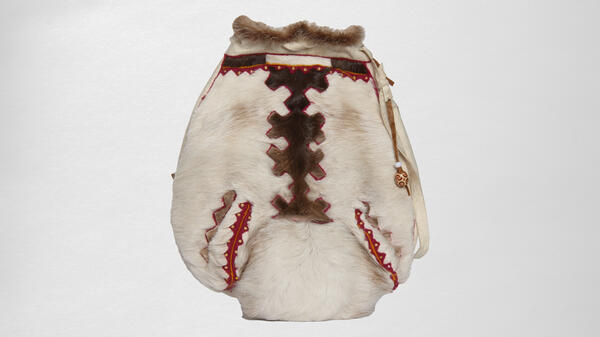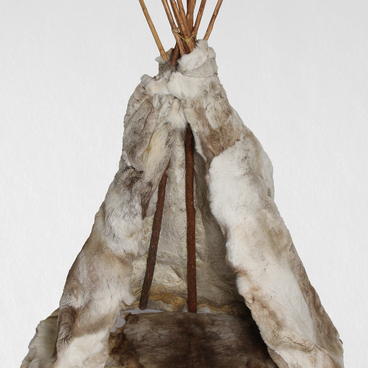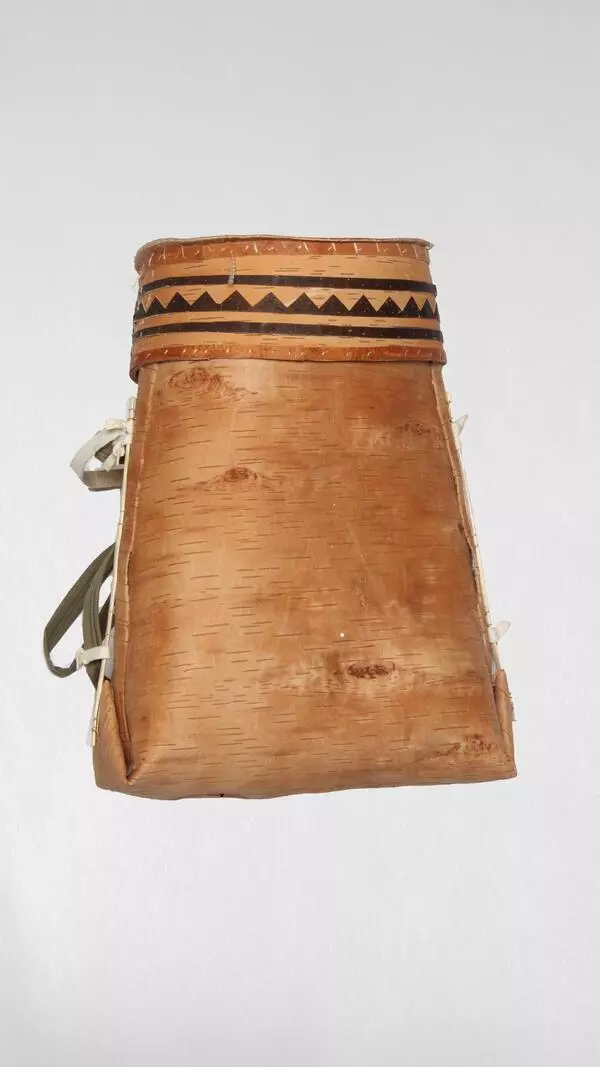The traditional handicraft bag called “tuchan” was an important item in the everyday life of Khanty women. The bag was used to store a pin cushion, tendon threads, thimbles, scissors, necklace and beads, elegant pieces of leather and fabrics.
Most often, a woman sewed a tuchan for herself from reindeer skins with fur on the indside and outside. But sometimes there were tuchans made of broadcloth, a densely knitted woolen fabric. The most popular color for this material was blue — the color of water.
The woman decorated a tuchan with fur and leather mosaics, ornaments, beads, metal pendants. According to Khanty beliefs, these patterns protected the owner from the influence of the dark forces of the Lower world. The front part of the bag was especially carefully decorated.
Tuchan was decorated with traditional patterns like “elk horns”, “sable heads” or “the sun”. The sun symbolized good luck, happiness and prosperity. The sacred ornament on the bag itself was also protected from evil forces by sewing pendants made of beads or thick fringe to the edge of the tuchan. The image was covered by hanging decorations.
By the age of 13–15, a Khanty girl should have several fur bags. The most important one was her tuchan. In it, next to the needles and threads, the girl kept her amulets. In addition to the amulets, there were two small dolls in the tuchan: a male and a female one. The Khanty believed that without these dolls of different sexes, the girl, when she gets married, would not have happiness and children.
The indigenous northern peoples, including the Khanty, had their own perceptions of beauty. A beautiful woman was considered, first of all, to be a skillful needlewoman, an parsimonious housewife and a caring mother. It was customary to choose a bride not by her appearance, but by the way she does household chores, makes skins and sews clothes and shoes from them. In wedding legends, the bride was always in good-quality beautiful clothes and with a fur bag in her hands.
The tuchan played a special role in the wedding ritual of the Khanty — in the rite of kidnapping the bride. The groom and one of his female relatives, such as his older sister, came to the girl’s yurt, met her in the street and secretly (so that her parents and friends would not know) encouraged her to marry.
If the girl agreed, she had to pick up her tuchan secretly and run away to the groom’s house. In this case, many Khanty girls kept the tuchan in the entryway so that they could quietly take it away with them. When the parents did not find either their daughter or her tuchan, they understood that she had not disappeared, but had gone to her beloved.
Most often, a woman sewed a tuchan for herself from reindeer skins with fur on the indside and outside. But sometimes there were tuchans made of broadcloth, a densely knitted woolen fabric. The most popular color for this material was blue — the color of water.
The woman decorated a tuchan with fur and leather mosaics, ornaments, beads, metal pendants. According to Khanty beliefs, these patterns protected the owner from the influence of the dark forces of the Lower world. The front part of the bag was especially carefully decorated.
Tuchan was decorated with traditional patterns like “elk horns”, “sable heads” or “the sun”. The sun symbolized good luck, happiness and prosperity. The sacred ornament on the bag itself was also protected from evil forces by sewing pendants made of beads or thick fringe to the edge of the tuchan. The image was covered by hanging decorations.
By the age of 13–15, a Khanty girl should have several fur bags. The most important one was her tuchan. In it, next to the needles and threads, the girl kept her amulets. In addition to the amulets, there were two small dolls in the tuchan: a male and a female one. The Khanty believed that without these dolls of different sexes, the girl, when she gets married, would not have happiness and children.
The indigenous northern peoples, including the Khanty, had their own perceptions of beauty. A beautiful woman was considered, first of all, to be a skillful needlewoman, an parsimonious housewife and a caring mother. It was customary to choose a bride not by her appearance, but by the way she does household chores, makes skins and sews clothes and shoes from them. In wedding legends, the bride was always in good-quality beautiful clothes and with a fur bag in her hands.
The tuchan played a special role in the wedding ritual of the Khanty — in the rite of kidnapping the bride. The groom and one of his female relatives, such as his older sister, came to the girl’s yurt, met her in the street and secretly (so that her parents and friends would not know) encouraged her to marry.
If the girl agreed, she had to pick up her tuchan secretly and run away to the groom’s house. In this case, many Khanty girls kept the tuchan in the entryway so that they could quietly take it away with them. When the parents did not find either their daughter or her tuchan, they understood that she had not disappeared, but had gone to her beloved.





